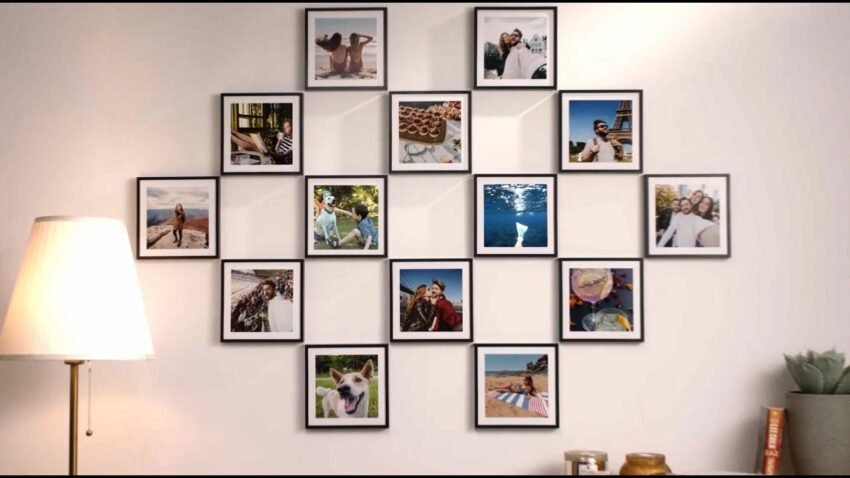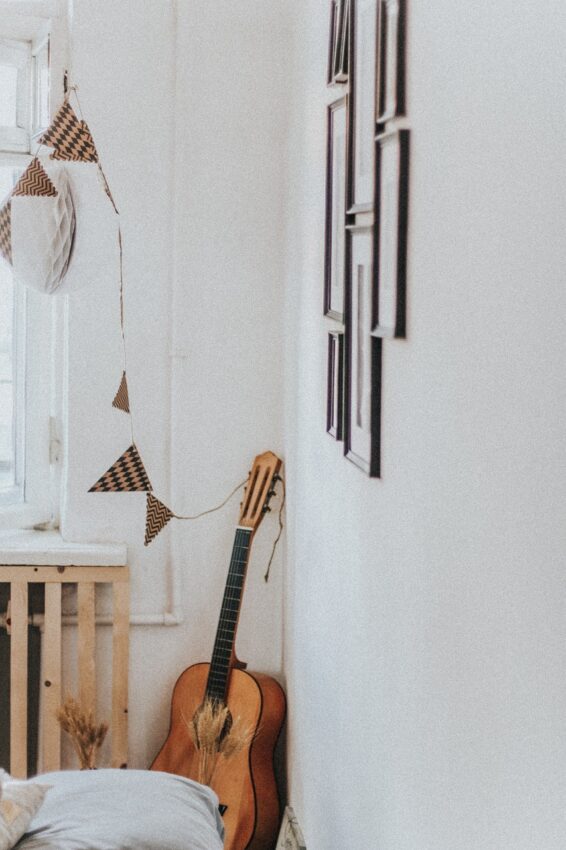Walking into a room where wall art seems to come alive with energy creates an immediate impression on visitors. This effect, known as kinetic gallery design, brings movement and dynamism to walls without anything actually moving.
Many homeowners find that thoughtfully arranged gallery wall art can turn a static wall into something that feels alive with motion and energy.
Whether someone needs to refresh their living room or add visual interest to a hallway, understanding how to create the illusion of movement can elevate displays from flat to fascinating.

Understanding Movement in Static Displays
Even though wall art doesn’t physically move, it can still create a powerful sense of motion that guides the eye and energizes a space. Many people learn this after hanging random frames that end up looking disconnected and lifeless.
Principles of Visual Flow
Visual flow is about creating pathways for the eye to follow. Arranging pieces in curved or diagonal lines rather than rigid rows helps create this sense of movement. Homeowners might try placing frames along an invisible S-curve or diagonal line across the wall. When gallery arrangements follow a gentle wave pattern rather than a grid, visitors often stop to appreciate the photos instead of just walking past.
Creating Directional Energy
Directional energy comes from the content of the art itself. Photos or artwork that contain directional elements—like a person looking toward another frame, an arrow, or a landscape with a clear horizon line—can create momentum across a display. Family photos arranged so that everyone appears to be looking toward a central piece can immediately create a sense of connection and movement that wasn’t there before.
Color and Pattern Dynamics
Colors and patterns dramatically influence how people perceive movement. Gradients of color that shift from one frame to the next create a visual journey. Arranging abstract prints in a color progression from cool blues to warm oranges can make a wall feel like it’s transitioning through a sunset. Similarly, patterns that repeat with slight variations across multiple pieces create rhythm and flow.

Interactive Gallery Elements
Taking movement beyond the visual realm into actual physical interaction adds another dimension to wall displays.
Rotating Frame Systems
Rotating frames allow homeowners to physically change their display without rearranging everything. The simplest version uses a centered nail or hook that allows the frame to be turned, while more advanced systems include mechanical elements that allow rotation with a touch. This flexibility makes seasonal updates much easier.
Sliding Panel Designs
Sliding systems bring literal movement to walls. Using track systems similar to sliding doors, these panels can move horizontally to reveal different artwork or photos behind them. This approach works particularly well in narrow spaces like hallways, effectively doubling display space while adding an interactive element visitors appreciate.
Modular Rearrangement Options
Modular systems offer perhaps the most flexible approach to kinetic gallery design. Using uniform frames or display boxes that can be easily rearranged allows for endless configurations. Some homeowners use sets of identical square frames that they reconfigure every few months—sometimes in a grid, sometimes in a staggered pattern, sometimes forming shapes like circles or diamonds.
Light and Shadow Choreography
Light transforms static displays into dynamic experiences that change throughout the day or at the flip of a switch.
Time-Based Shadow Play
Strategic placement of three-dimensional elements or frames that stand off from the wall can create evolving shadow patterns as natural light changes throughout the day. In west-facing rooms, mounting several frames at different distances from the wall creates subtle morning shadows but dramatic evening shadows that make the display feel completely different.
LED Integration Techniques
Adding LED lighting behind frames or within display elements creates dramatic effects and can be programmed to change colors or intensity. Simple LED strip lights behind a collection of translucent art pieces can transform the mood from energetic mornings with bright white light to relaxing evenings with a soft amber glow.
Natural Light Positioning
Working with a room’s natural light sources can create dynamic displays that change with the sun’s position. Considering how sunlight moves across walls throughout the day when planning a layout makes a significant difference. Some gallery walls come alive at specific times when the sun hits at just the right angle, highlighting textures and casting interesting shadows that aren’t visible at other times.
Smart Solutions for Rental-Friendly Movement
Living in a rental doesn’t mean sacrificing dynamic wall displays—it just requires damage-free approaches.
Magnetic Systems
Magnetic systems offer incredible flexibility without damaging walls. Using either a magnetic paint base or thin metal sheets attached to walls with removable adhesive creates surfaces that hold magnetic-backed frames or art pieces. This approach allows for weekly rearrangement without a single hole in the wall.
Removable Track Solutions
Lightweight track systems that attach with removable adhesive strips provide structure for hanging art that can slide and move. Picture rails mounted near the ceiling with removable hooks allow art to hang from nearly invisible wires and easily slide horizontally. This solution works particularly well for textured walls that don’t accommodate standard adhesive hangers.
Temporary Mounting Techniques
Products like removable mounting putty, adhesive hooks, and specialized picture hanging strips make it possible to create dynamic displays without permanent damage. These can create “floating” arrangements where lightweight frames appear to hover at different distances from the wall, creating depth and movement without a single nail.
The Mixtiles Advantage in Dynamic Displays
Lightweight, adhesive-backed photo tiles offer particular advantages for creating movement-driven displays.
Creating Flow with Photo Arrangements
The uniform size and lightweight nature of photo tiles make them perfect for creating flowing arrangements that guide the eye. Displays can spiral outward from a central image, creating a sense of expansion, or flow like a river across a wall, guiding visitors through a space. The consistent frame style helps maintain visual cohesion while the arrangement itself creates movement.
Easy Repositioning Benefits
The ability to easily peel off and reposition adhesive-backed tiles makes experimenting with dynamic layouts much less intimidating. When trying to create a display that mimics birds in flight, for example, homeowners might rearrange photo tiles multiple times before finding the perfect formation—something nearly impossible with traditional framed pictures requiring nails and hooks.
Multi-Pattern Layout Strategies
With lightweight, uniform tiles, creating complex patterns becomes much simpler than with heavier or irregularly sized frames. Displays can transition from tight clusters to dispersed arrangements, mimicking the effect of something bursting outward. The visual impact creates a sense of frozen movement that energizes the entire room.
Technical Considerations
Behind every successful kinetic display are practical considerations that ensure safety and longevity.
Weight Distribution
Understanding proper weight distribution is crucial, especially for displays with physical movement elements. Always using appropriate wall anchors for heavier pieces, and considering the cumulative weight of grouped items prevents accidents. When installing rotating panel systems, anchoring tracks into wall studs rather than just drywall helps prevent potential disasters.
Balance and Safety
For truly kinetic elements that move, balance is essential for both aesthetics and safety. Testing moving parts thoroughly before finalizing installation ensures that children and pets can’t dislodge elements that might fall. Adding small rubber bumpers to the back corners of frames in high-traffic areas prevents them from being knocked askew by passing shoulders.
Maintenance Requirements
Moving parts require occasional maintenance. Sliding tracks may need lubrication, pivot points might loosen over time, and motorized elements need power source considerations. Keeping a small kit with frame-leveling tools, lubricant spray, and extra hardware nearby allows for quick fixes as needed.
Advanced Movement Integration
Once the basics are mastered, displays can evolve more dramatically over time.
Seasonal Rotation Plans
Planning seasonal changes adds anticipation and freshness to a space. Many homeowners maintain a core gallery layout that stays consistent but swap about 30% of the images seasonally—bright, vibrant photos for spring and summer, warmer tones and cozier scenes for fall and winter. The partial change creates enough movement to feel refreshed without requiring a complete redesign.
Event-Based Transformations
Special occasions offer perfect opportunities to temporarily transform displays. For birthdays, temporarily adding childhood photos of the person being celebrated to the main gallery wall creates a personalized touch. For holidays, integrating themed elements that can be easily removed afterward keeps the space current. These temporary changes create a sense of the home responding to and participating in life events.
Progressive Display Evolution
The most sophisticated approach to kinetic gallery design is creating displays that intentionally evolve over time. A “growth wall” where new photos are added at regular intervals in a predetermined pattern can be particularly meaningful. What starts as a single central image might grow outward like rings on a tree, documenting a family’s life in their home. Visitors who come regularly notice the evolution, creating a fourth-dimensional art experience that incorporates time itself.
Creating movement in wall displays doesn’t require complex technology or special skills—just thoughtful arrangement and a willingness to experiment. Whether using simple repositionable photo tiles or investing in more elaborate systems, the principles of visual flow and dynamic design can transform walls from static surfaces into energetic, engaging elements that feel alive with movement.
